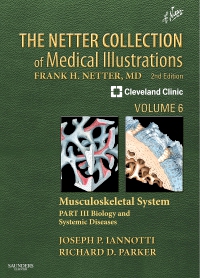
The Netter Collection of Medical Illustrations: Musculoskeletal System, Volume 6, Part III - Biology and Systemic Diseases, 2nd Edition
Hardcover

Newer Edition Available
-
- Get complete, integrated visual guidance on the musculoskeletal system with thorough, richly illustrated coverage.
- Quickly understand complex topics thanks to a concise text-atlas format that provides a context bridge between primary and specialized medicine.
- Clearly visualize how core concepts of anatomy, physiology, and other basic sciences correlate across disciplines.
- Benefit from matchless Netter illustrations that offer precision, clarity, detail and realism as they provide a visual approach to the clinical presentation and care of the patient.
-
- Gain a rich clinical view of embryology; physiology; metabolic disorders; congenital and development disorders; rheumatic diseases; tumors of musculoskeletal system; injury to musculoskeletal system; soft tissue infections; and fracture complications in one comprehensive volume, conveyed through beautiful illustrations as well as up-to-date radiologic and laparoscopic images.
- Benefit from the expertise of Drs. Joseph Iannotti, Richard Parker, and esteemed colleagues from the Cleveland Clinic, who clarify and expand on the illustrated concepts.
- Clearly see the connection between basic science and clinical practice with an integrated overview of normal structure and function as it relates to pathologic conditions.
- See current clinical concepts in orthopaedics and rheumatology captured in classic Netter illustrations, as well as new illustrations created specifically for this volume by artist-physician Carlos Machado, MD, and others working in the Netter style.
-
SECTION 1—EMBRYOLOGY
DEVELOPMENT OF MUSCULOSKELETAL SYSTEM
1-1 Amphioxus and Human Embryo at 16
Days, 2
1-2 Differentiation of Somites into Myotomes,
Sclerotomes, and Dermatomes, 3
1-3 Progressive Stages in Formation of
Vertebral Column, Dermatomes, and
Myotomes; Mesenchymal Precartilage
Primordia of Axial and Appendicular
Skeletons at 5 Weeks, 4
1-4 Fate of Body, Costal Process, and Neural
Arch Components of Vertebral Column,
With Sites and Time of Appearance of
Ossification Centers, 5
1-5 First and Second Cervical Vertebrae at
Birth; Development of Sternum, 6
1-6 Early Development of Skull, 7
1-7 Skeleton of Full-Term Newborn, 8
1-8 Changes in Position of Limbs Before Birth;
Precartilage Mesenchymal Cell
Concentrations of Appendicular Skeleton
at 6 Weeks, 9
1-9 Changes in Ventral Dermatome Pattern
During Limb Development, 10
1-10 Initial Bone Formation in Mesenchyme;
Early Stages of Flat Bone Formation, 11
1-11 Secondary Osteon (Haversian
System), 12
1-12 Growth and Ossification of
Long Bones, 13
1-13 Growth in Width of a Bone and Osteon
Remodeling, 14
1-14 Remodeling: Maintenance of Basic
Form and Proportions of Bone During
Growth, 15
1-15 Development of Three Types of Synovial
Joints, 16
1-16 Segmental Distribution of Myotomes in
Fetus of 6 Weeks; Developing Skeletal
Muscles at 8 Weeks, 17
1-17 Development of Skeletal Muscle
Fibers, 18
1-18 Cross Sections of Body at 6 to
7 Weeks, 19
1-19 Prenatal Development of Perineal
Musculature, 20
1-20 Origins and Innervations of Pharyngeal
Arch and Somite Myotome Muscles, 21
1-21 Branchiomeric and Adjacent Myotomic
Muscles at Birth, 22
SECTION 2—PHYSIOLOGY
2-1 Microscopic Appearance of Skeletal
Muscle Fibers, 25
2-2 Organization of Skeletal Muscle, 26
2-3 Intrinsic Blood and Nerve Supply of
Skeletal Muscle, 27
2-4 Composition and Structure of
Myofilaments, 28
2-5 Muscle Contraction and Relaxation, 29
2-6 Biochemical Mechanics of Muscle
Contraction, 30
2-7 Sarcoplasmic Reticulum and Initiation of
Muscle Contraction, 31
2-8 Initiation of Muscle Contraction by Electric
Impulse and Calcium Movement, 32
2-9 Motor Unit, 33
2-10 Structure of Neuromuscular Junction, 34
2-11 Physiology of Neuromuscular
Junction, 35
2-12 Pharmacology of Neuromuscular
Transmission, 36
2-13 Physiology of Muscle Contraction, 37
2-14 Energy Metabolism of Muscle, 38
2-15 Muscle Fiber Types, 39
2-16 Structure, Physiology, and
Pathophysiology of Growth Plate, 40-41
2-17 Structure and Blood Supply of Growth
Plate, 42
2-18 Peripheral Fibrocartilaginous Element of
Growth Plate, 43
2-19 Composition and Structure of
Cartilage, 44
2-20 Bone Cells and Bone Deposition, 45
2-21 Composition of Bone, 46
2-22 Structure of Cortical (Compact) Bone, 47
2-23 Structure of Trabecular Bone, 48
2-24 Formation and Composition of
Collagen, 49
2-25 Formation and Composition of
Proteoglycan, 50
2-26 Structure and Function of Synovial
Membrane, 51
2-27 Histology of Connective Tissue, 52
2-28 Dynamics of Bone Homeostasis, 53
2-29 Regulation of Calcium and Phosphate
Metabolism, 54
2-30 Effects of Bone Formation and Bone
Resorption on Skeletal Mass, 55
2-31 Four Mechanisms of Bone Mass
Regulation, 56
2-32 Normal Calcium and Phosphate
Metabolism, 57
2-33 Nutritional Calcium Deficiency, 59
2-34 Effects of Disuse and Stress (Weight
Bearing) on Bone Mass, 60
2-35 Musculoskeletal Effects of Weightlessness
(Space Flight), 61
2-36 Bone Architecture and Remodeling in
Relation to Stress, 62
2-37 Stress-Generated Electric Potentials in
Bone, 63
2-38 Bioelectric Potentials in Bone, 64
2-39 Age-Related Changes in Bone
Geometry, 65
2-40 Age-Related Changes in Bone Geometry
(Continued), 66
SECTION 3—METABOLIC DISEASES
3-1 Parathyroid Hormone, 68
3-2 Pathophysiology of Primary
Hyperparathyroidism, 69
3-3 Clinical Manifestations of Primary
Hyperparathyroidism, 70
3-4 Differential Diagnosis of Hypercalcemic
States, 71
3-5 Pathologic Physiology of
Hypoparathyroidism, 72
3-6 Clinical Manifestations of Chronic
Hypoparathyroidism, 74
3-7 Clinical Manifestations of
Hypocalcemia, 75
3-8 Pseudohypoparathyroidism, 76
3-9 Mechanism of Parathyroid Hormone
Activity on End Organ, 77
3-10 Mechanism of Parathyroid Hormone
Activity on End Organ: Cyclic AMP
Response to PTH, 78
3-11 Clinical Guide to Parathyroid Hormone
Assay: Different Forms of PTH and Their
Detection by Whole (Bioactive) PTH and
I-PTH Immunometric Assays, 79
3-12 Clinical Guide to Parathyroid Hormone
Assay (Continued), 80
3-13 Childhood Rickets, 81
3-14 Adult Osteomalacia, 82
3-15 Nutritional Deficiency: Rickets and
Osteomalacia, 83
3-16 Vitamin D–Resistant Rickets and
Osteomalacia due to Proximal Renal
Tubular Defects (Hypophosphatemic
Rachitic Syndromes), 84
3-17 Vitamin D–Resistant Rickets and
Osteomalacia due to Proximal and Distal
Renal Tubular Defects, 85
3-18 Vitamin D–Dependent (Pseudodeficiency)
Rickets and Osteomalacia, 86
3-19 Vitamin D–Resistant Rickets and
Osteomalacia due to Renal Tubular
Acidosis, 87
3-20 Metabolic Aberrations of Renal
Osteodystrophy, 88
3-21 Rickets, Osteomalacia, and Renal
Osteodystrophy, 89
3-22 Bony Manifestations of Renal
Osteodystrophy, 90
3-23 Vascular and Soft Tissue Calcification in
